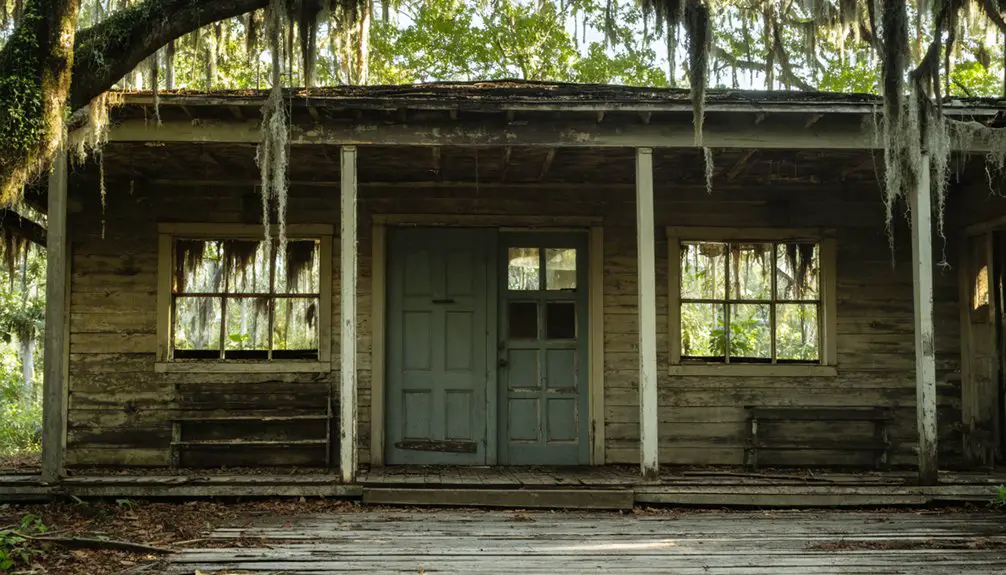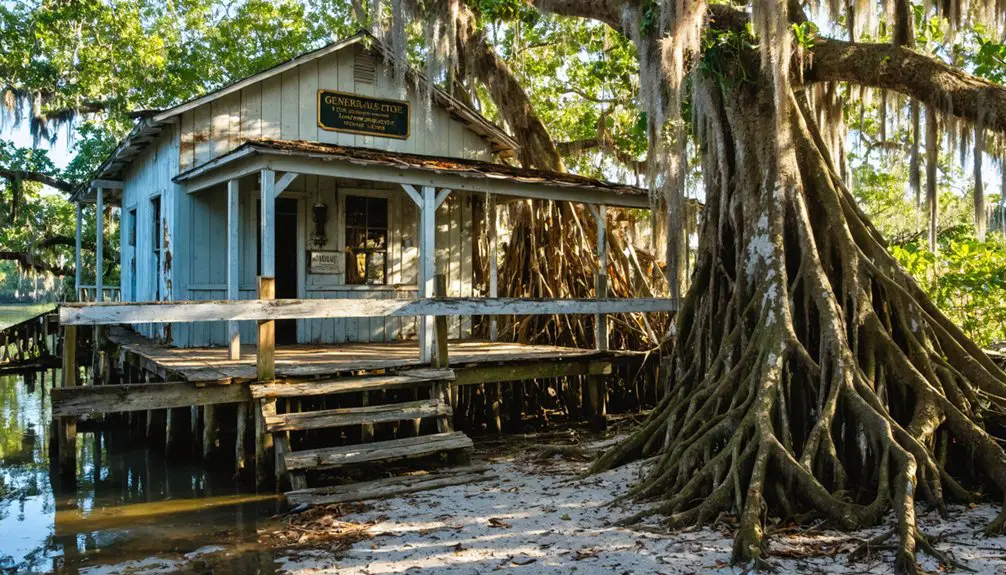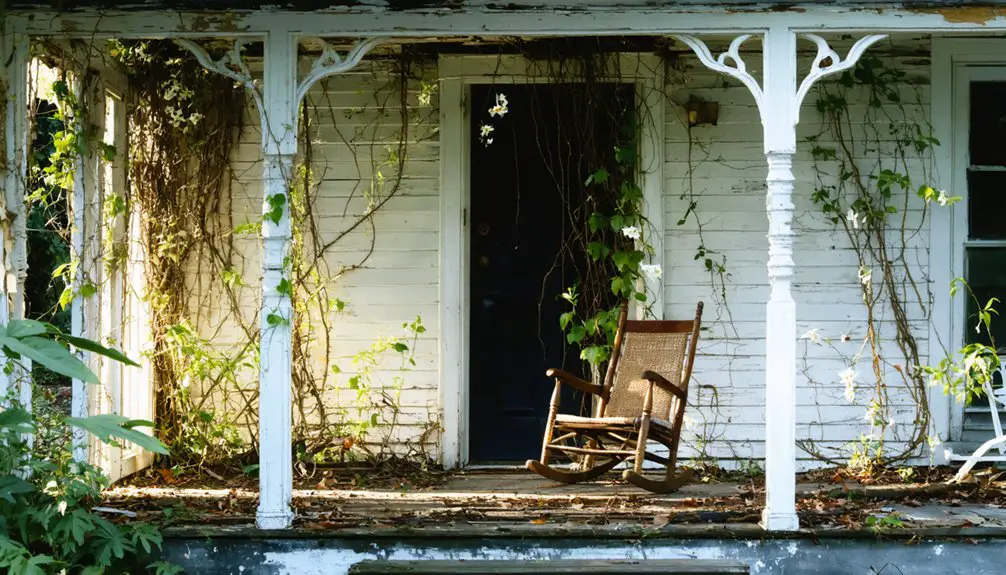You’ll find Pinecrest’s ruins deep in Florida’s southeastern wilderness, where it emerged in the early 1900s during Flagler’s railroad boom. This frontier town became a notorious bootlegging haven during Prohibition, with Al Capone establishing a mansion there for his operations. The Gator Hook Lodge served as a cultural hub until 1977, but devastating hurricanes ultimately led to abandonment. Today, the site lies protected within Big Cypress National Preserve, holding secrets of its lawless past.
Key Takeaways
- Pinecrest emerged in early 1900s Florida as a construction camp during Flagler’s Overseas Railroad project, attracting diverse settlers.
- The town thrived during Prohibition as a bootlegging hub, with Al Capone establishing a fortified mansion for his operations.
- Gator Hook Lodge served as the community’s cultural center from 1958-1977, hosting hunters, fishermen, and local residents.
- Devastating hurricanes and flooding eventually forced residents to abandon the remote settlement.
- The site now exists within Big Cypress National Preserve, with protected ruins standing 7 feet above sea level.
The Rise of a Frontier Boom Town
While Florida’s southeastern wilderness remained largely untamed in the early 1900s, Pinecrest emerged from a pristine landscape of pine rockland and hardwood hammock.
You’d find the pioneer spirit alive as Henry Flagler’s Overseas Railroad project transformed the area into a bustling construction boom camp, drawing workers and settlers to this frontier outpost.
W.J. Willingham’s acquisition of the land from James Jaudon marked a turning point, as he promoted Pinecrest to risk-taking investors during Florida’s early land boom.
Willingham saw promise in Pinecrest’s wild frontier, transforming raw land into opportunity for bold investors seeking Florida’s untapped potential.
The completion of the Tamiami Trail in the 1920s further opened up opportunities, connecting this remote settlement to the wider region.
The area’s rugged appeal attracted an enterprising mix of gator hunters, loggers, farmers, and even bootleggers, all seeking their fortune in this untamed corner of the Everglades.
Located six miles west of Forty Mile Bend, the town became a strategic stopping point for travelers and traders.
Life in the Lawless Everglades
You’d find yourself in a world beyond the law’s reach in Pinecrest, where the dense Everglades swamps and maze-like waterways created perfect hideouts for bootleggers and outlaws.
The settlement’s extreme isolation, sitting 6 miles west of Fortymile Bend at just 7 feet above sea level, meant that Monroe County authorities from Key West rarely ventured into this frontier territory. The area required careful disambiguation of locations due to several similarly named places in Florida.
In this untamed environment, residents survived through a mix of legal and illegal pursuits – from alligator hunting and frogging to operating establishments like the notorious Gator Hook saloon, which stood as a symbol of the area’s lawless character until 1977.
Remote Frontier Justice
Because of its remote location and challenging terrain, Pinecrest and the surrounding Everglades frontier operated under a system of informal justice throughout the early 20th century.
You’d find a harsh but practical approach to maintaining order, where local justice often meant taking matters into your own hands. The vast wetlands spanning 40-50 miles wide created perfect conditions for frontier lawlessness, keeping formal authorities at bay. The infamous Al Capone’s mansion brought an additional criminal element to the already untamed region.
- Self-reliant settlers enforced their own rules, sometimes through violent means
- Native American groups added complexity to territorial disputes and trading conflicts
- The region’s “island mentality” bred resistance to outside law enforcement
- Smuggling networks thrived along remote coastlines, especially during the 1980s
The wilderness provided natural cover for those seeking to live beyond conventional law, making federal intervention nearly impossible in this untamed territory. A March 1987 operation led to the seizure of 431 bales of marijuana from two boats, highlighting the area’s ongoing challenges with drug trafficking.
Bootleggers’ Hidden Paradise
During the roaring twenties, Pinecrest emerged as a bootlegger’s dream within the vast Everglades wilderness. You’d find hidden waterways threading through mangrove islets, creating perfect clandestine routes for running Cuban and Bahamian liquor.
Local guides mastered these maze-like passages, using airboats to navigate shallow swamps while evading law enforcement. The saltwater Cowboys later applied these same navigation skills during the drug trade of the 1970s.
The town’s remoteness from Key West’s authorities made it irresistible to characters like Al Capone, who established a mansion and brothel here.
You could catch live music at Gator Hook Lodge, where profits from illegal spirits kept the drinks flowing.
The surrounding cypress forests provided natural cover for liquor caches, while Loop Road and the Tamiami Trail connected smugglers to thirsty clients.
Violence occasionally erupted, but the promise of quick money kept the bootlegging trade alive.
Survival Beyond Authority
Beyond bootlegging’s allure, life in Pinecrest demanded raw survival skills and adaptability. The remote Everglades settlement, six miles west of Fortymile Bend, operated under self governance practices where formal law held little sway. Tales of unsolved murders and mysterious disappearances haunted the region, adding to its lawless reputation.
Community resilience emerged through necessity, as residents developed informal systems to handle disputes and protect their interests.
Your survival in Pinecrest depended on:
- Mastering Everglades ecology for food, shelter, and avoiding natural dangers
- Building trusted networks within the mixed population of pioneers and outlaws
- Learning specialized skills in alligator hunting, fishing, and frogging
- Steering through social dynamics at gathering spots like Gator Hook Lodge
Without formal authority, you’d find a hardened society where vigilante justice prevailed and daily life required both physical prowess and social intelligence to endure the harsh realities of Everglades existence.
Al Capone’s Hidden Florida Haven
You’ll find Al Capone’s former mansion hidden in the once-lawless region of Pinecrest, northern Monroe County, where he operated an extensive bootlegging network during Prohibition.
The strategic location allowed Capone’s operation to flourish, as the remote Everglades setting provided ideal cover for his illegal activities while maintaining connections to both Miami and Tampa. After facing an 11-year prison sentence for tax evasion in 1932, his criminal empire began to crumble.
The mansion served not only as Capone’s personal retreat but as a base camp for coordinating his Florida bootlegging empire, though his name was carefully kept off official property records to shield his involvement. In his later years, he lived a much quieter life there, spending his days fishing and relaxing by the pool.
Capone’s Mansion Remains Today
Hidden away in the remote wilderness of Pinecrest, Florida, Al Capone’s mansion once stood as a strategic retreat roughly 6 miles west of Fortymile Bend.
During Prohibition, this lawless settlement provided the perfect cover for Capone’s activities, combining both residential comfort and criminal enterprise operations. The property, which he acquired for $40,000 in 1928, became his primary Florida residence.
Today, you’ll find only scattered ruins protected by the National Park Service within Big Cypress National Preserve.
The site’s historical significance remains, though physical evidence is minimal.
- Original foundation remnants sit at 7 feet above sea level
- A former gas station’s ruins mark the property’s perimeter
- Access requires explicit National Park Service authorization
- The site is fenced to prevent trespassing and preserve its historic value
The mansion’s remote location and sparse law enforcement made it an ideal sanctuary for Capone’s bootlegging network and underground operations.
Bootlegging Operations Base Camp
The remote Pinecrest mansion served as more than just a luxurious retreat – it was a sophisticated base camp for Al Capone’s extensive bootlegging operations in South Florida.
You’ll find evidence of his bootlegging legacy in the property’s strategic features: a 7-foot cement wall for security, powerful searchlights to ward off law enforcement, and an oversized 25-foot boat dock for discreet liquor transportation.
From this hidden haven, Capone’s illicit operations flourished through a network of speakeasies and gambling establishments, including one run by his own brother.
The Loop Road area became notorious for moonshine distilleries and brothels. Through his connection with hotelier Parker Henderson, Capone expanded his influence, supplying high-quality liquor to influential figures like judges and law enforcement while maintaining his Chicago syndicate’s winter base of operations.
The Legendary Gator Hook Lodge

Deep within the untamed wilderness of Big Cypress Swamp, Gator Hook Lodge opened its doors in 1958 along the notorious Loop Road near Pinecrest, Florida.
Owned by former Sweetwater police chief Jack Knight, this legendary establishment quickly became Florida’s roughest tavern and a cultural hub for the region’s most hardened characters.
Under Jack Knight’s watch, Gator Hook Lodge became a raw sanctuary where Florida’s toughest souls found their kindred spirits.
- You’d find hunters, fishermen, froggers, and moonshiners gathering here nightly.
- Knight enforced a “no guns or knives inside” policy, though weapons were common.
- Only plastic ashtrays and cans were used, anticipating the frequent brawls.
- Saturday nights brought heavy drinking, local music, and inevitable fights.
The lodge operated until 1977, when the Big Cypress National Preserve absorbed the area.
Today, the Gator Hook stands as a symbol of Florida’s vanishing frontier spirit and the untamed culture of the Gladesmen who called it home.
Economic Activities and Local Culture
During Pinecrest’s early frontier years, resourceful settlers carved out a living through diverse extractive industries that capitalized on the region’s natural abundance.
You’d find alligator hunters stalking the Everglades for hides and meat, while loggers harvested the dense pine forests. Farmers cleared palmetto thickets for homesteads, and fishermen worked the waters.
The community’s economic resilience showed in its adaptability – when Prohibition arrived, bootleggers thrived in the remote location far from Key West’s law enforcement.
Cultural adaptation manifested in the vibrant social scene at Gator Hook Lodge, where fiddler Ervin Rouse’s music echoed through the night. The frontier ethos bred a tough, independent spirit, though this sometimes erupted in brawls and shootings.
Tourism emerged later with attractions like Parrot Jungle, but natural disasters and economic downturns ultimately limited its growth.
Natural Disasters and Abandonment

While Pinecrest’s resourceful community had adapted to frontier challenges, natural disasters ultimately proved insurmountable.
Situated just 7 feet above sea level in the Big Cypress National Preserve, the town’s vulnerability to hurricanes and flooding sealed its fate. The devastating hurricanes of the early 20th century, particularly in 1926, combined with the Great Depression’s economic decline to force residents into abandonment.
Low elevation and devastating storms proved insurmountable for Pinecrest, as nature and economic hardship forced residents to abandon their homes.
- Repeated storm damage destroyed homes and essential infrastructure
- Limited evacuation options due to remote location
- Loss of hunting and farming livelihoods from environmental disruption
- Declining patronage at Gator Hook Lodge weakened social bonds
The natural disasters’ cumulative impact accelerated Pinecrest’s transformation into protected wilderness under federal management, as the National Park Service acquired the depopulated lands for conservation.
Remnants of the Past
Today’s visitors to Pinecrest encounter scattered remnants of its frontier past throughout the Big Cypress National Preserve. During historical exploration, you’ll find gas station ruins along the Tamiami Trail and Al Capone’s partially standing home, though you’ll need permission to access it.
The site of the legendary Gator Hook Lodge, where Ervin Rouse performed “The Orange Blossom Special,” is now bulldozed near Loop Road’s S curve.
The ecological impact of nature’s reclamation is evident as vegetation overtakes former structures. You can spot foundations and debris of old residences, while abandoned roads fade into the swamp. A few occupied trailers remain, but wildlife has largely reclaimed the area.
The town’s coordinates at 25°44′49″N 80°56′24″W mark what was once a bustling frontier settlement.
Preservation Efforts and Access

Since becoming part of the Big Cypress National Preserve in 1974, Pinecrest has benefited from National Park Service protection and management. The preservation techniques implemented by NPS focus on maintaining historical authenticity while ensuring visitor access via Loop Road, a 24-mile dirt path connecting to Tamiami Trail.
You’ll need to follow these visitor regulations when exploring Pinecrest:
- Stay on designated paths to protect archaeological remains
- Avoid trespassing on private property still inhabited near preserve boundaries
- Refrain from unauthorized construction or commercial activities
- Use only approved vehicles on Loop Road, especially during wet seasons
The NPS continues stabilizing remaining structures and monitoring environmental impacts, while maintaining Loop Road for safe passage.
Their approach emphasizes preserving the ghost town’s character rather than reconstructing it completely.
Tales From the Ghost Town
Deep in the heart of Florida’s Big Cypress, Pinecrest’s storied past reads like a wild frontier tale from the 1920s.
You’ll find pioneer legends filled with gunfights, bootlegging, and brawls from an era when the nearest law enforcement was miles away in Key West.
The town’s most notorious tales center around Al Capone’s alleged mansion, hotel, and brothel, where ghostly encounters are said to occur to this day.
Local stories passed down through generations paint a vivid picture of life at the Gator Hook Lodge, where the famous fiddler Ervin Rouse played “The Orange Blossom Special” for dancers and drinkers.
Fiddle music from Ervin Rouse echoed through Gator Hook Lodge, where locals gathered to dance and drink into the night.
While most buildings have crumbled, leaving only scattered ruins, the area’s dangerous reputation lives on through warnings from locals who’ll tell you to stay away from the decaying structures.
Frequently Asked Questions
Are There Any Dangerous Wildlife Encounters Reported in Present-Day Pinecrest?
You’ll be glad to know there aren’t any reported dangerous wildlife encounters in present-day Pinecrest, though standard safety measures like avoiding feeding animals and staying on marked paths are still recommended.
What Was the Highest Recorded Population of Pinecrest During Its Peak?
You won’t find documented peak population figures for the historic Pinecrest ghost town, though Pinecrest Village in Miami-Dade County, an entirely different location, reached its demographic peak of 19,052 in 2000.
Do Any Original Pinecrest Families Still Live in the Surrounding Area?
With land acquisition by the National Park Service in 1977, you won’t find original Pinecrest families in the area today. The last remaining descendants moved out when the Gator Hook Lodge closed permanently.
Was There Ever a School or Church Established in Pinecrest?
You’ll find historical records showing a small school existed, though it didn’t survive the Depression. There’s no confirmed evidence of a church, though community gatherings likely occurred at Gator Hook Lodge.
What Items Have Been Found by Archaeologists Excavating the Pinecrest Ruins?
You’ll find archaeological findings like animal bones from deer, turtles, fish, and snakes, plus historic artifacts including a palm-sized scraper and Simpson point dating back 13,500 years ago.
References
- https://en.wikipedia.org/wiki/Pinecrest
- https://www.ghosttowns.com/states/fl/pinecrest.html
- https://bostonraremaps.com/inventory/pinecrest-florida-1932/
- https://www.allinmiami.com/blog/top-5-things-you-may-not-know-about-pinecrest
- https://www.youtube.com/watch?v=bIjc1X2CvYQ
- https://opesre.com/blog/from-tropical-wilderness-to-residential-haven-tracing-the-rich-history-of-pinecrest
- https://jacquithurlowlippisch.com/tag/the-great-florida-land-boom/
- https://npshistory.com/publications/bicy/adhi.pdf
- https://www.nps.gov/ever/learn/historyculture/pioneersettlement.htm
- http://www.gribblenation.org/2017/05/2017-southeast-trip-part-11-us-41.html



